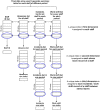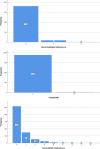Quantifying the impact of environment factors on the risk of medical responders' stress-related absenteeism
- PMID: 35285544
- PMCID: PMC9544400
- DOI: 10.1111/risa.13909
Quantifying the impact of environment factors on the risk of medical responders' stress-related absenteeism
Abstract
Medical emergency response staff are exposed to incidents which may involve high-acuity patients or some intractable or traumatic situations. Previous studies on emergency response staff stress-related absence have focused on perceived factors and their impacts on absence leave. To date, analytical models on absenteeism risk prediction use past absenteeism to predict risk of future absenteeism. We show that these approaches ignore environment data, such as stress factors. The increased use of digital systems in emergency services allows us to gather data that were not available in the past and to apply a data-driven approach to quantify the effect of environment variables on the risk of stress-related absenteeism. We propose a two-stage data-driven framework to identify the variables of importance and to quantify their impact on medical staff stress-related risk of absenteeism. First, machine learning techniques are applied to identify the importance of different stressors on staff stress-related risk of absenteeism. Second, the Cox proportional-hazards model is applied to estimate the relative risk of each stressor. Four significant stressors are identified, these are the average night shift, past stress leave, the squared term of death confirmed by the Emergency Services and completion of the safeguarding form. We discuss counterintuitive results and implications to policy.
© 2022 The Authors. Risk Analysis published by Wiley Periodicals LLC on behalf of Society for Risk Analysis.
Figures











Similar articles
-
Approaches for predicting long-term sickness absence. Re: Schouten et al. "Screening manual and office workers for risk of long-term sickness absence: cut-off points for the Work Ability Index".Scand J Work Environ Health. 2015 May 1;41(3):322-323. doi: 10.5271/sjweh.3483. Epub 2015 Feb 2. Scand J Work Environ Health. 2015. PMID: 25639964
-
Prevalence and causes of medical absenteeism among staff (case study at mazandaran university of medical sciences: 2009-2010).Mater Sociomed. 2013 Dec;25(4):233-7. doi: 10.5455/msm.2013.25.233-237. Epub 2013 Nov 24. Mater Sociomed. 2013. PMID: 24511264 Free PMC article.
-
Pandemic (H1N1) 2009 Influenza in Australia: Absenteeism and redeployment of emergency medicine and nursing staff.Emerg Med Australas. 2011 Oct;23(5):615-23. doi: 10.1111/j.1742-6723.2011.01461.x. Epub 2011 Aug 8. Emerg Med Australas. 2011. PMID: 21995477
-
Job demands, job resources and long-term sickness absence in the Danish eldercare services: a prospective analysis of register-based outcomes.J Adv Nurs. 2012 Jan;68(1):127-36. doi: 10.1111/j.1365-2648.2011.05724.x. Epub 2011 Jun 9. J Adv Nurs. 2012. PMID: 21658095
-
The effectiveness of mindfulness based programs in reducing stress experienced by nurses in adult hospital settings: a systematic review of quantitative evidence protocol.JBI Database System Rev Implement Rep. 2015 Oct;13(10):21-9. doi: 10.11124/jbisrir-2015-2380. JBI Database System Rev Implement Rep. 2015. PMID: 26571279
Cited by
-
Impact of the COVID-19 Pandemic on Musculoskeletal Disorder-Related Absenteeism Among Pediatric Healthcare Workers.Healthcare (Basel). 2025 May 11;13(10):1116. doi: 10.3390/healthcare13101116. Healthcare (Basel). 2025. PMID: 40427953 Free PMC article.
References
-
- Antoniadis, A. , Lambert‐Lacroix, S. , & Poggi, J.‐M. , (2021). Random forests for global sensitivity analysis: A selective review. Reliability Engineering & System Safety, 206, 107312
-
- Alba, A. C. , Agoritsas, T. , Walsh, M. , Hanna, S. , Iorio, A. , Devereaux, P. J. , & Guyatt, G. (2017). Discrimination and calibration of clinical prediction models: Users' guides to the medical literature. Journal of the American Medical Association, 318(14), 1377–1384. - PubMed
-
- Boot, C. R. L. , Drongelen, A. v. , Wolbers, I. , Hlobil, H. , Beek, A. J. V. D. , & Smid, T. (2017). Prediction of long‐term and frequent sickness absence using company data. Occupational Medicine, 67(3), 176–181. - PubMed
-
- Brid, R. S. (Producer) . (2018). Introduction to decision trees. https://medium.com/greyatom/decision‐trees‐a‐simple‐way‐to‐visualize‐a‐d...
-
- Burns, C. , & Harm, N. J. (1993). Emergency nurses' perceptions of critical incidents and stress debriefing. Journal of Emergency Nursing, 19(5), 431–436. - PubMed
MeSH terms
LinkOut - more resources
Full Text Sources
Miscellaneous

